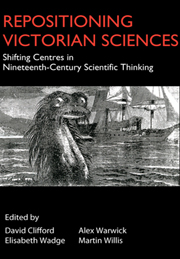Book contents
- Frontmatter
- Contents
- Notes on Contributors
- 1 Margins and Centres
- SECTION I Shifted Centres
- SECTION II Contested Knowledges
- 7 ‘Supposed Differences’: Lydia Becker and Victorian Women's Participation in the BAAS
- 8 A Fair Trial for Spiritualism?: Fighting Dirty in the Pall Mall Gazette
- 9 ‘This is Ours and For Us’: The Mechanic's Magazine and Low Scientific Culture in Regency London
- 10 How did the Conservation of Energy Become ‘The Highest Law in All Science’?
- 11 ‘Scriptural Geology’, Vestiges of the Natural History of Creation and Contested Authority in Nineteenth-Century British Science
- 12 ‘This House is a Temple of Research’: Country-House Centres for Late Victorian Science
- SECTION III Entering The Modern
- Notes
- Select Bibliography
12 - ‘This House is a Temple of Research’: Country-House Centres for Late Victorian Science
from SECTION II - Contested Knowledges
Published online by Cambridge University Press: 05 March 2012
- Frontmatter
- Contents
- Notes on Contributors
- 1 Margins and Centres
- SECTION I Shifted Centres
- SECTION II Contested Knowledges
- 7 ‘Supposed Differences’: Lydia Becker and Victorian Women's Participation in the BAAS
- 8 A Fair Trial for Spiritualism?: Fighting Dirty in the Pall Mall Gazette
- 9 ‘This is Ours and For Us’: The Mechanic's Magazine and Low Scientific Culture in Regency London
- 10 How did the Conservation of Energy Become ‘The Highest Law in All Science’?
- 11 ‘Scriptural Geology’, Vestiges of the Natural History of Creation and Contested Authority in Nineteenth-Century British Science
- 12 ‘This House is a Temple of Research’: Country-House Centres for Late Victorian Science
- SECTION III Entering The Modern
- Notes
- Select Bibliography
Summary
The present chapter considers sidelined sites of science in the late-Victorian period, precisely the moment during which many historians have characterized the sciences as having transformed into specialized professions based in academic and government-sponsored research facilities, like the Cavendish Laboratory, Cambridge and the Royal Botanic Gardens, Kew. The growth and character of these facilities have received much historical attention; yet, surprisingly, their forerunners have not. If we agree that a significant institutional shift took place during this period, we might ask what were those forerunner institutions and what became of them?
Several histories of Anglo-American scientific institutions have contributed to a ‘canon’ of nineteenth-century science as a progress story of a shift from ‘amateur’ to ‘professional’ science in which the former involved individual, leisurely endeavours and the latter professional teams, working in ‘Big Science’ at new research institutions. Contemporary late-Victorian discourse championed state-supported research while bemoaning the inadequacy of private initiative. More recent laboratory studies, in turn, have tended to celebrate specialized, extra-domestic sites – museum, laboratory, observatory – while sidelining ‘private’ domestic spaces. The image has emerged of ‘domestic’ science as quaint and idiosyncratic, although various scholars are succeeding in dismantling this skewed representation.
One of the best documented cases of a nineteenth-century amateur tradition, located at the private estate of John William Strutt, third Baron Rayleigh, Terling Place, in Essex, has helped create this idiosyncratic imagery.
- Type
- Chapter
- Information
- Repositioning Victorian SciencesShifting Centres in Nineteenth-Century Thinking, pp. 143 - 154Publisher: Anthem PressPrint publication year: 2006
- 5
- Cited by



